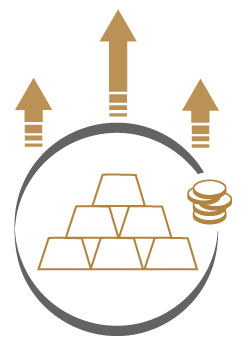
In theory, stagflation was never meant to happen. Economists had convincingly claimed that only when economies are growing rapidly and resources are constrained would inflation be expected to rise. Weak growth, by implication, would suggest a return to weaker inflation and possibly deflation. That’s why the stagflation of the 1970s made no sense, or so it seemed.
A portmanteau of stagnation and inflation, stagflation was marked by an era of weak growth yet soaring inflation, in double-digits at times, all amidst high oil prices and rising gold prices. Policy makers attempted to reverse this trend, seemingly banishing high inflation from our lives for good. However, current policies designed to reflate the world economy during the pandemic could risk returning us to this high-inflation world sooner than we realise. Gold could once again return as the ultimate hedge against inflation.
The post-war consensus crumbles
The original stagflation era traces its origins back to the response of policy makers to the Great Depression of the 1930s. To successive post-war governments, the 1930s represented deflation and high unemployment, and the government began to ramp up spending in order to support the economy more than ever before. Full employment was prioritised over other objectives, meaning the labour market was growing and more people were in work than ever before.
However, a tight labour market coincided with a bout of poor productivity from the 1960s onwards, as the UK lagged behind the likes of Japan, the US and West Germany, using lower-quality technology to produce less goods for a higher price. Each time the government allowed a boom to commence, inflation would start to rise too high, forcing an about-turn and higher interest rates, stifling growth and forcing an easing of policy. This stop-and-go policy led to a point by 1979 in which inflation was rising in double-digit figures on an annual basis.
Gold, which had been fixed in price for several decades, was no longer linked to the US dollar from 1971, allowing the price of gold to rise in a parabolic price pattern until 1980, surging to new heights that would have seemed inconceivable a decade before. However, considering the devaluation of the pound due to inflation and other factors doesn’t make this such a surprise, as gold was simply following the path of making up for an erosion in the pound’s purchasing power. By the early 1980s, stagflation was seemingly conquered through austerity and high interest rates.
The result was mass deindustrialisation, high unemployment and a reduced rate of inflation, falling to a level that allowed an independent Bank of England to start considering an inflation target of two per cent per annum. Full employment was quietly ditched in favour of what economists call ‘price stability, where prices rose enough to spur spending, but not so high that the currency lost its value. The UK inflation rate has more or less remained firmly close to this target, despite the financial crisis, a slowing global economy and the pandemic.
Inflation returns centre stage
The economy has rebounded from the pandemic with record rates of economic growth which will admittedly return to more sustainable levels in line with the long-term trends. Even so, the low interest rates, quantitative easing and fiscal easing permitted by UK policy makers has pumped billions of fresh pounds into the UK economy. While the pandemic inflicted some long-lasting damage to the economy, stimulus helps push the economy further than it otherwise would have managed by itself.
This will have a great impact on inflation in the long run. If policy makers turn off the taps at the right time, the economy can continue to grow at a sustainable rate without generating excessive levels of inflation. If they mistime it, letting stimulus remain in place for that bit too long, the consequences could be devastating. The economy could overheat, and return the UK to rates of inflation which require drastic action, impacting future growth. Gold prices are playing a waiting game, remaining close to the all-time highs made in the summer of 2020.
All it takes is a small policy mistake or a negative slew of data for several months in a row and gold could break for new all-time highs, making the current dip a major buying opportunity as a new bull run gets underway. In the 1970s, gold prices multiplied by over 2,000 per cent. In the bull run of the last 20 years, prices rose by a more modest 700 per cent or so, suggesting that there is plenty of room for buying gold before it achieves a similar price rise.
If prices do indeed continue to rise at an ever-increasing rate, buying gold could be one of the more obvious ways of protecting wealth, if inflation does finally return after a slumber of more than a generation. The Gold Bullion Company is an experienced provider of gold bullion products, as well as items struck in silver, palladium and platinum. Past performance is no guarantee of future results, but a number of variables are in place which could easily set events in motion to bring about a higher rate of inflation than many expect.
One of the biggest problems many faced in the last 20 years was being blindsided by the economic booms and busts which seemingly came out of nowhere. However, if you had bought gold close to its 1999 low point, you would have been part of an exciting journey which has seen gold reaffirm its place as an effective hedge against economic instability. Gold has traditionally also been a useful hedge against weak currencies and inflation, and this other quality could come back to the fore in the coming years. History has told us that life rarely follows a straight path, but can be highly cyclical. What will you do, when the next inflationary episode begins?















